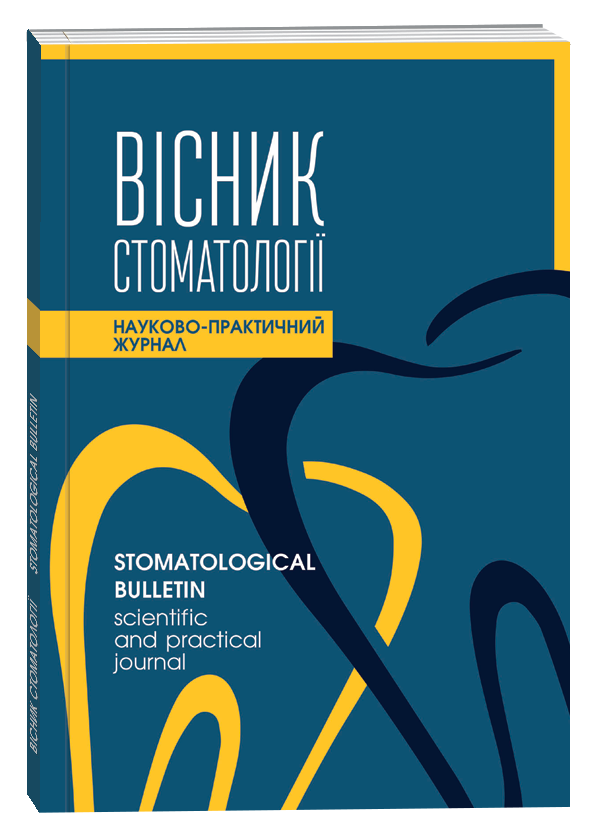CLINICAL EFFICIENCY OF DIFFERENT TYPES OF PROSTHETICS OF EDENTULOUS MANDIBLE DEPENDING ON THE TYPE OF ITS ATROPHY
DOI:
https://doi.org/10.35220/2078-8916-2021-39-1-24-30Keywords:
complete absence of teeth on mandible, alveo-lar bone atrophy, complete denture prosthesis, dental im-plantation, clinical efficiencyAbstract
The article presents the results of the comparative clinical and functional study of the effectiveness of prosthetics in 300 patients with edentulous mandibles depending on the type of atrophy and design of denture fixation (by using closing valve or due to fixation on locator- and ball-abutments). It has been established that the use of "clas-sic" complete removable dentures is the most effective in type I of the edentulous mandible, when under the condi-tion of satisfactory function of dentures it is possible to prevent progressive atrophy of the bone tissue of the pros-thetic bed. Whereas, in types II, IIІ and IV, a similar clinical effect is possible only due to additional mechani-cal fixation on implants. The obtained data correspond to the results of previous studies of stress-strain states.
References
Novozemtseva T. N., Remizova A. A., Uzunyan N. A. i dr. Vozmozhnosti vnutrikostnoy implantatsii dlya uluchsheniya fiksatsii s"emnykh protezov pri polnoy adentii. Rossiyskiy stomatologicheskiy zhurnal. 2016;20(5):257-259. [In Russian]
Malkarova I. V., Kaplan M. Z., Kaplan Z. M., Tigranyan Kh. R. Polnye s"emnye protezy s oporoy na vnutrikostnykh implantatakh. Zdorov'e i obrazovanie v KhKhІ veke. 2016;2(18):255-257. [In Russian]
Fastovec' O. O., Sapal'ov S. OPorivnjal'na kliniko-funkcional'na ocinka efektyvnosti protezuvannja hvoryh z povnoju vidsutnistju zubiv na nyzhnij shhelepi povnymy znimnymy protezamy ta znimnymy protezamy z oporoju na implantaty. Visnyk stomatologii'. 2019;1(31): 64-68. [in Ukrain-ian]
Fastovec' O. O., Sapal'ov S. O., Shtepa V. O. Rezul'taty doslidzhennja napruzheno-deformovanyh staniv pry protezuvanni riznyh typiv atrofii' nyzhn'oi' bezzuboi' shhelepy. Medychni perspektyvy. 2020;XXV,4:146-158. [in Ukrainian]
Alsrouji M. S., Ahmad R., Abdul Razak N. H. et al. Premaxilla stress distribution and bone resorption induced by implant overdenture and conventional denture. Journal of Pros-thodontics. 2019;28 (2): 764-770. doi: 10.1111/jopr.12954.
Lebedenko I. Ju., Kalivradzhijana Je. S., Ibragimova T.P. Rukovodstvo po ortopedicheskoj stomatologii. Prote-zirovanie pri polnom otsutstvii zubov. Moskva. MIA; 2005:400 [In Russian]
Lebedenko I. Ju., Ibragimov T. I., Rjahovskij A. N.. Funkcional'nye i apparaturnye metody issledovanija v ortopedicheskoj stomatologii. Moskva. MIA; 2003:128. [In Rus-sian]
Janishen I. V., Djudina I. L., Tomilin V. G. y dr. Provedennja elektromiografichnogo doslidzhennja v ortopedychnij stomatologii'. H.: HNMU; 2017:114. [in Ukraini-an]
Postić S. D. Influence of balanced occlusion in complete dentures on the decrease in the reduction of an edentulous ridge. Vojnosanit Pregl. 2012; 69 (12):1055-1060.
Fastovec' O.O., Glazunov A.O. Ocinka klinichnoi' efektyvnosti povnyh znimnyh proteziv, vygotovlenyh za vdoskonalenoju metodykoju funkcional'nogo vidbytka. Visnyk mors'koi' medycyny. 2017;1:122-128. [in Ukrainian]
Cheng H. C., Peng B. Y., Chen M. S. et al. Influence of deformation and stress between bone and implant from various bite forces by numerical simulation analysis. BioMed Research International. 2017. doi: 10/1155/2017/2827953.
Lahoti K., Pathrabe A., Gade J. Stress analysis at bone-implant interface of single- and two-implant-retained mandibu-lar overdenture using three-dimensional finite element analysis. Indian Journal of Dental Research. 2016;27(6):597-601. doi: 10.4103/0970-9290.199587.









